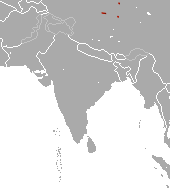| Koslov's pika | |
|---|---|
 | |
| Scientific classification | |
| Kingdom: | Animalia |
| Phylum: | Chordata |
| Class: | Mammalia |
| Order: | Lagomorpha |
| Family: | Ochotonidae |
| Genus: | Ochotona |
| Species: | O. koslowi |
| Binomial name | |
| Ochotona koslowi (Buchner, 1894) | |
 | |
| Koslov's pika range | |
Koslov's pika or Kozlov's pika (Ochotona koslowi) is a species of mammal in the family Ochotonidae. It is endemic to China. Its natural habitat is tundra. It is threatened by habitat loss. Kozlov's pika are herbivores, they are known as "ecosystem engineers" as they're known to promote diversity of different plants species. Specifically, this species of Pikas has been enlisted as "endangered" in China. Kozlov Pikas are estimated to be within the Northern edge of the Arkatag Range in China.
